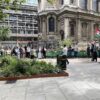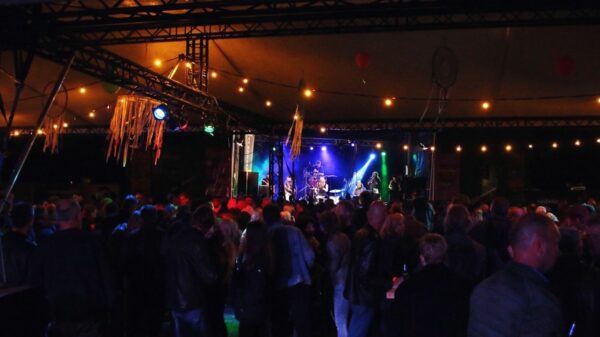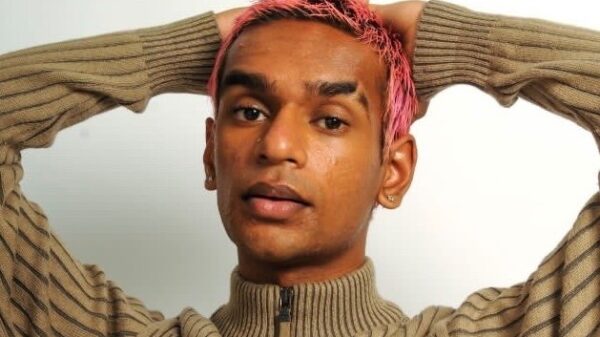Staff Writer Klara Ismail reviews Soufiane Ababri’s new commission which opened on 13 March at The Curve in Barbican Centre.
Editor’s note: this article discusses nudity and themes of sexual nature.
The gallery space is dark and dimly lit with red lights. Eyes must adjust to the glow. Hidden behind a sparkling beaded curtain and cradled within the natural curve of the exhibition space, the often-nude but always-blushing male bodies of Soufiane Ababri’s drawings can be found.

Ababri’s new commission at The Barbican is his first solo exhibition at a major UK institution. The Moroccan-born gay artist explores themes of queerness, diaspora and LGBTQ+ people of colour. He lives and works between Paris and Tangier.
While nudity is a large part of Ababri’s work, it is not used to eroticise or fetishize his subjects. He is acutely aware of the “very strong homoeroticism towards the Arab body that’s really a consequence of colonialism”. Nudity in his ‘Bedwork’ collection, featured in The Curve installation, symbolises trust, vulnerability and intimacy – not necessarily sexual, between men of colour.
Ababri’s work “challenges the dominance of Western narratives in queer history” and wants us to recognise that the queer nightclub is not an innocently liberatory safe space, but a messy site of resistance. It is contested not just by homophobia from the outside world, but also by racial and gendered systems of power which favour white male individuals. These systems have historically been, and still are, reinforced on the queer dancefloor and in the LGBTQ+ community. LGBTQ+ ethnic minorities report feeling marginalised, objectified, and subject to racist stereotypes within the LGBTQ+ community. Ababri’s drawings are a testament to Moroccan queer lives and communities which exist outside of Western European ideals.
Initially, I’m struck by Ababri’s call for an indulgent celebration of queer desire through the unabashed nudity of his subjects. Most of the drawings are set in the bedroom, with naked or semi-naked men lying sprawled across a mattress. Often, they are in pairs and seem to find solace in sharing each other’s gaze or grins.

Remnants of their night litter the scenes – an empty can of Camden Hells lager, cigarette stubs, bits of coloured confetti, a used condom and unidentified colourful liquids. Despite its historically covert status, these objects all serve as evidence of the existence of the queer nightclub even after the night ends. They simultaneously reveal the culture to those unfamiliar with the queer dance scene.
Yet there are also feelings of shame, fear, and pain seeping into the moods of the later drawings in this installation. Oscar Wilde’s ‘The Ballad of Reading Gaol’, written about his experiences in prison convicted on suspicion of homosexual acts, is featured in one of the drawings. In another, a man with a bleeding wound on his head is comforted by a worrying friend or lover.

The exhibition sees the floor of The Curve provocatively hand-painted in red with the Arabic letter Zayin (ز) as it follows the shape of the gallery itself. Ababri shares that when he saw the shape of the Barbican Curve, it reminded him of the letter’s curling form and it is the first letter of the word ‘zamel’, a derogatory slur used to describe gay men in the Maghreb.
In an interview with The Guardian, Ababri expands on his personal history with the term: “It’s a word I heard at school … I have no doubt queer and LGBT children in Morocco still face it: that repeated zzzz sound, like a bumblebee, as you walk past people in school corridors”.
Considering the gallery space as the entry to the queer nightclub, I half-expect to hear the low thumping of bass as I walk through Ababri’s conceptualisation of the dancefloor. But it’s that ‘zzzz‘ sound which is played from speakers and fills the room.
The viewer must try to ignore the irritating droning noise in order to be fully immersed in the vibrant vulnerability of the drawings before them. Otherwise, they become distracted and deny the queer subjects of Ababri’s artwork their full appreciation and consideration. Yet focusing on that sound, or getting irritated by it, won’t help stop the noise. In a similar vein, simply focusing on homophobic acts won’t make them go away.
Ababri’s installation reminds us that the truly affirmative act of resistance is focusing on keeping queer lives visible and heard until their collective voices are loud enough to drown out the noise.
The installation is free to visit and will be showing from 13 March to 30 June 2024. A performance will be held at the exhibition on 30th June 2024. More information can be found at Soufiane Ababri | Barbican.

















